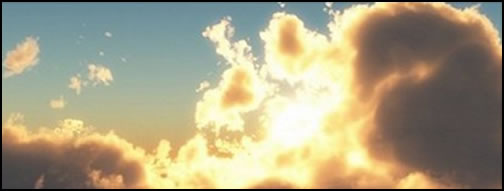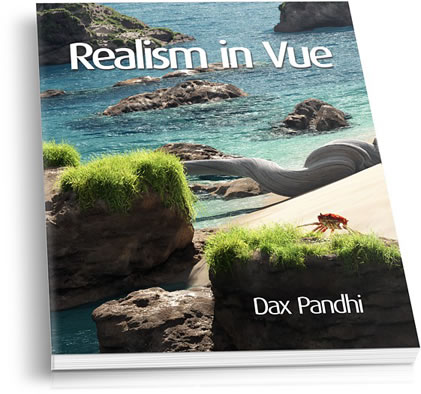Dax Pandhi has been writing tutorials and creating material for E-on Software's Vue for many years now. Early on, I reviewed a number of his tutorials under the other name he is known by which is Quadspinner™: Mighty HyperTerrains - Volume 1, The Beauty of Strata, Capturing the Brilliance of Light, and Realistic Procedural Terrains. Dax is not only a skilled technical creator but a skilled artist as well. This brings multiple perspectives to his work. For years now, one of his aims has been to create incredible realism in Vue. To this end he has travelled and photographed scenes and then used Vue to create very realistic landscapes.
This brief bio of Dax is taken from his website of daxpandhi.com:
 "I would love to create a world in Vue and live there."
"I would love to create a world in Vue and live there."
"Dax Pandhi is both artist and technician. His scientific mind prods him to probe, challenge and invent. The results of these trials are refined by his masterful eye for composition and story. Dax's innovations in CGI are testament to his deeper understanding of nature's processes and his effective translation of that knowledge onto the digital platform.
"Dax is also a gifted teacher. Beyond this book, he has gained popularity through his training videos that share his unique methods in a simple format. "Learning all of this doesn't mean anything if I can't share it with others.
"Dax's artistic roots are in traditional painting and photography - each serving as a feedback loop for the other. In 2007, he released his first photography book, Visit to Earth. He is currently working on two other photo books.
"Outside of his background in art, Dax has built a successful career in technology, ranging from CGI to software programming. Based on his innovative design work and service under his company Nukeation Studios, Dax was awarded Microsoft's MVP for 3 consecutive years. He served as journalist for Associated Press covering the aftermath of the devastating 2001 earthquake in Bhuj. He is proficient in 8 computer languages and 4 human languages.
Dax lives in the desert in Bhuj, India."
Realism in Vue is written to span different versions of Vue from Vue 7 through Vue 9. You can abstract from it what applies to your version or edition. It is beautifully laid out with large color illustrations on every page. All are very legible, even the ones that show screens with text. The over 300 page 8 1/2" by 11" book is divided into chapters that encompass the realm of many of his great tutorials. Obviously there are many sections dealing with light. Dax breaks Vue down into small pieces and shows how these pieces mesh with each other. Often one works with a knowledge gained by experience but doesn't put it into words. Dax has taken that knowledge and described it. When I first looked at the book, I took a section at random - Aerial Perspective - to see how he described it. He demonstrates clearly its function in a manner easy to remember and apply. The book explains why the events happen in the real world and how he reproduces them in Vue. His examples are beautiful and numerous: In his cloud section he has added many examples with their settings so that one can understand how these settings relate to each other.

In the beginning of the book, Dax talks about the importance of scale. I was having problems on some images getting the atmospheric effects I wanted as well as the perspective especially with distant objects. I kept working with the atmosphere tab and got the effect I wanted to some degree. After reading this section, I revamped my whole scale, I was working very small, to real life scale and everything fell into place easily in exactly the manner I envisioned. That alone was worth the cost of the book. Somehow working in real life scale never clicked completely until I read Realism in Vue.
The book deals with definitive areas in Vue such as Atmosphere and its components with an emphasis on how to use Global Radiosity as the basic light for creating realistic scenes as well as explaining why specific techniques, functions, and settings work in Vue and how they correspond to the natural environment. He goes into detail on such factors as Anisotropy as well as Cloud Anisotropy. It is hard to list all the areas, so I will just list the major chapters in the book:
Chapter 1 - Introduction Chapter 2 - Natural Atmospheres Chapter 3 - Advanced Atmospherics Chapter 4 - Terrains Chapter 5 - HyperTerrains and HyperBlobs | Chapter 6 - Materials Chapter 7 - Ecosystems Chapter 8 - Waterscapes Chapter 9 - Perception Appendix - Precise Antialiasing,Customizing Render Settings, and Object Antialiasing |
The chapter on Terrains emphasize using the Function Editor to create a realistic terrain, especially the Terrain Fractal and Strata Filter. He describes what the various settings do and their importance in creating realistic terrains. I have mainly used images from the Realism In Vue website rather than scan in examples from the book. The book is loaded with examples of both screen captures of settings as well as images and parts of images that Dax has created to demonstrate a concept.

What one needs to remember is the level of the book - Intermediate to Advanced. You do need a basic knowledge to make use of his information. Looking at some of his tutorials while reading the book was useful but not mandatory. But having a basic knowledge of creating procedural terrains using the Function Editor is necessary.
In his section on Terrains, he shows how easy it is to create HyperTerrains and the variations you can achieve by just using the Fractal functions inherent to Vue. He shows how MetaBlobs, HyperTerrains, Hyper Textures, etc. are all interrelated while each is unique in its strengths. His descriptions show the immense possibilities Vue has.
The Function Editor is important in Vue and often appears to be overwhelming. Dax starts out with a simple material created in the Function Editor and goes on to show how it can be influenced by various nodes, etc. As Dax describes more complicated setups in the Function Editor, the users knowledge prior to reading his book needs to be greater.
Immediately upon opening the book, I found parts that radically changed an old image. His intertwining of explanations and examples make the book not only extremely useful but very interesting to read. This book is not only an excellent reference if you want your work to be realistic. I do not do "realism" but instead create in Vue for the purpose of postwork manipulation to change the image from realistic. However, I am a big proponent in all art forms that it is important to know how to create realistically before you manipulate an image. This book has invaluable information. It is all about possibilities.
This is not a how-to step-by-step book. One often needs to take what he says, and if the initial steps are not known, find a tutorial that addresses those. Then, reread his section and apply the knowledge. Since Vue 9 changed the scaling, one does often have to modify some of the settings presented. To me, the settings presented are guides to what can be accomplished in the realm of realistic landscapes in Vue. It would have been helpful if he had mentioned which version of Vue he was using when presenting settings that had to do especially with scaling.
What would have been very useful with the book is examples on a disk that either came with the book or could be downloaded. When materials are discussed, for example, it seems to be with the emphasis on what they can be, not how to actually create them. I believe the approach in some areas is too global. Even thought this is not a step-by-step how-to book from my perspective, analyzing some of his examples would be highly useful. That is why it would be useful to be able to analyze what is in the Function Editor for a greater understanding. I wish there was more complete information on how Dax accomplished certain looks rather than the fact that, yes, the looks can be accomplished. While he does go into how to set materials for MetaWater, I could not simulate what he did because there were too many unknown factors such as atmosphere used, sun position, etc. This would be helpful because then it is easier to take the knowledge and apply it to one's own situation once one has been able to create his model.
Realism in Vue is incredibly informative. It has to be remembered, in my opinion, that this is not a step-by-step how-to book, but a book that shows what can be done and leads the reader to experiment given Dax's perspective on how to create realism in Vue. One aspect that I found particularly interesting was his use of objects beyond the camera view to manipulate EcoSystems as well as act as reflectors. This is the type of information that is plentiful in the book and is exceptionally useful. I learnt a lot from it, but more importantly, I got many ideas. And, yes, I did read it from cover to cover.
The cost of the book until July 18th, 2011 is $49.95 and after, it is $59.95. It can be purchased from Amazon.com or from e-onsoftware.com online store.
More information on Dax Pandhi can be found on these websites: E-on software, Dax Pandhi, and Quadspinner.
